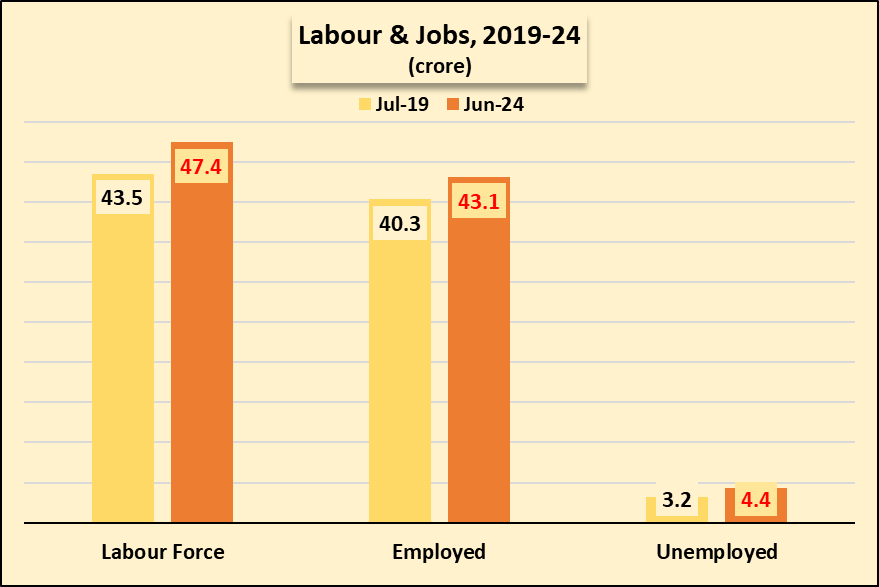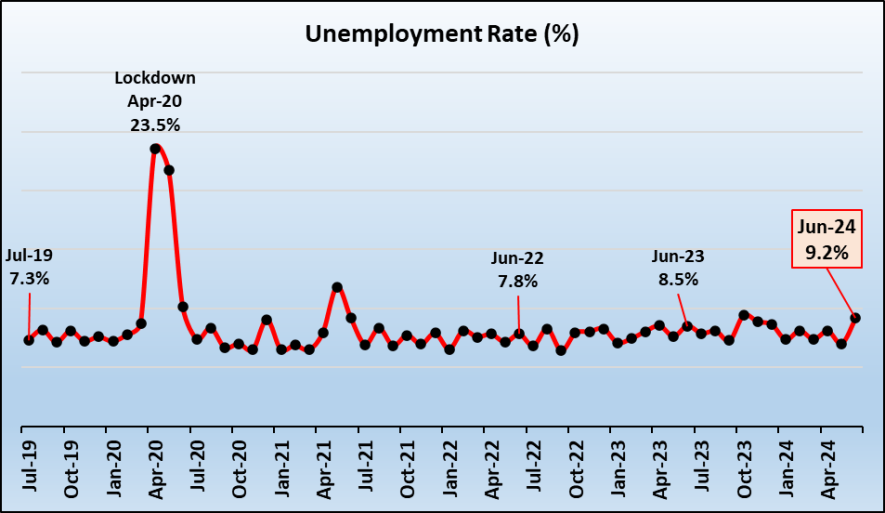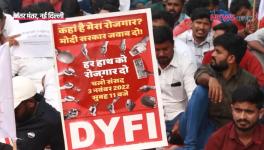Budget 2024-25: Will Govt Address the Jobs Crisis?

Image Courtesy: Peoples Dispatch
In the past five years, between 2019 and 2024, while the number of employed persons increased by about 2.8 crore, the number of jobless persons too went up by 1.2 crore, according to latest data from the periodic surveys conducted by the CMIE (Centre for Monitoring Indian Economy). That means that while the share of the employed went up by 7%, the share of the unemployed shot up by a staggering 36% in that period. Note that this period starts from before the pandemic and ends well after that.
One would expect that the country’s finance minister will reflect on this sobering reality and include – indeed, focus on – employment-creating policies in the Union Budget 2024-25 to be presented on July 23. Or maybe not – because the government appears to be rather blithely lauding the recent Reserve Bank of India data which says that over 8 crore jobs were created in just the past 3-4 years.
As shown in the chart below, India’s workforce increased from an estimated 43.5 crore in 2019 to 47.4 crore in 2024. The workforce comprises all those people, over 15-years of age, who are either working or actively seeking work. This growth is natural since population is increasing.
The number of employed persons, meanwhile, went up from 40.3 crore to 43.1 crore, an increase of about 7%. The number of unemployed (defined as those actively seeking work) went up from 3.2 crore to 4.4 crore.

CMIE also collects data for another category of persons – working age people who are willing to work but have stopped actively seeking work. This may be because they have become discouraged with no jobs available. Such persons are usually not counted among the unemployed although they are willing to work. Their number, according to CMIE data, is estimated at about 2.2 crore, up by over 89 lakh since 2019.
Unemployment Rate
Usual attention is focused on unemployment rates which are the proportion of working age persons who are willing to work and are actively seeking work. This proportion, according to CMIE, was at a disturbingly high level of 9.2% in June 2024, just short of hitting the double digit mark.
The chart below, based on CMIE data for unemployment between 2019 and 2024, shows that unemployment is a chronic condition in these times, mostly ranging above 6-7%, with some months crossing the 9% mark. The effect of lockdown and Covid are clearly visible in the peaks in April 2020, when joblessness was recorded at a staggering 23.5% and then in May 2021, during the second wave of the pandemic, when it hit 11.8%.

What is notable is that unemployment rates have settled at a higher level than the pre-pandemic times, and there is a discernible upward trend. If we compare the June unemployment rates over the past two years, one can see that in June 2022 it was 7.8%, in June 2023 it was 8.5% and now, in June 2024 it has reached 9.2%. This is a worrying sign of a crisis that is simply not going away.
Low Paying Jobs
In the absence of well paying and secure jobs, the increase in employment is mainly concentrated in the agricultural sector. This started during the lockdown in 2020, when migrant workers returned to villages. The same work is now being done by more people, which means lower returns, lower productivity, displacement of women to unpaying jobs. In other words, it is hidden unemployment – distressed people are simply working to survive. That is why 80 crore people need to be given free foodgrain every month through the public distribution system.
A recently released National Sample Survey Office or NSSO report on the unincorporated sector enterprises has highlighted that there were over 6.4 crore such small enterprises in India in which an estimated 11 crore persons are working. That gives an idea of the tiny nature of these enterprises – most of them are just one single person involved in retail sale or transport services, or selling eatables.
In fact other government surveys, like the Periodic Labour Force Survey (PLFS), have repeatedly shown that the rise in employment is mainly taking place in the self-employed category.
Faced with a dire economic crisis of low income and high inflation, families are forced to undertake myriad methods of earning something to make ends meet. This includes temporary work, multiple jobs, selling of various low-priced goods and services and, the deployment of women to do unpaid work, in addition to their usual domestic work. The PLFS reported that about 37% of women are doing unpaid work.
In short, the employment crisis is both – lack of jobs and compulsion to take up low paying, temporary work for survival. Surely, the Union Budget should be addressing what is the most crucial economic crisis that the country has been facing.
Get the latest reports & analysis with people's perspective on Protests, movements & deep analytical videos, discussions of the current affairs in your Telegram app. Subscribe to NewsClick's Telegram channel & get Real-Time updates on stories, as they get published on our website.
























